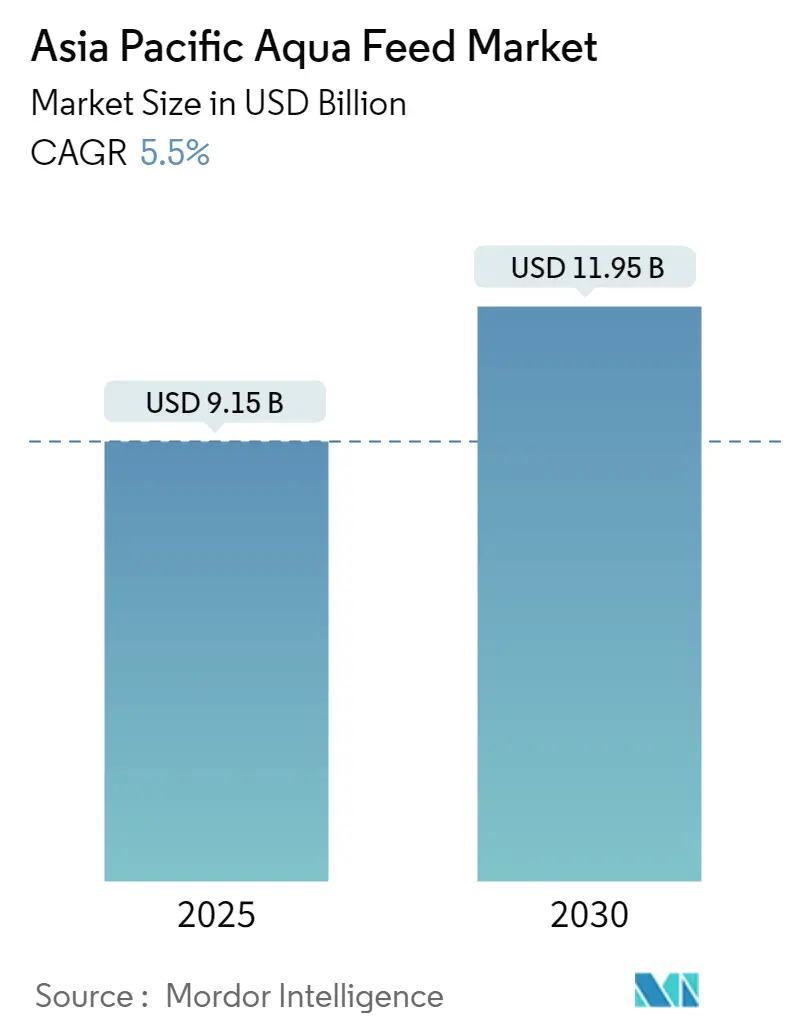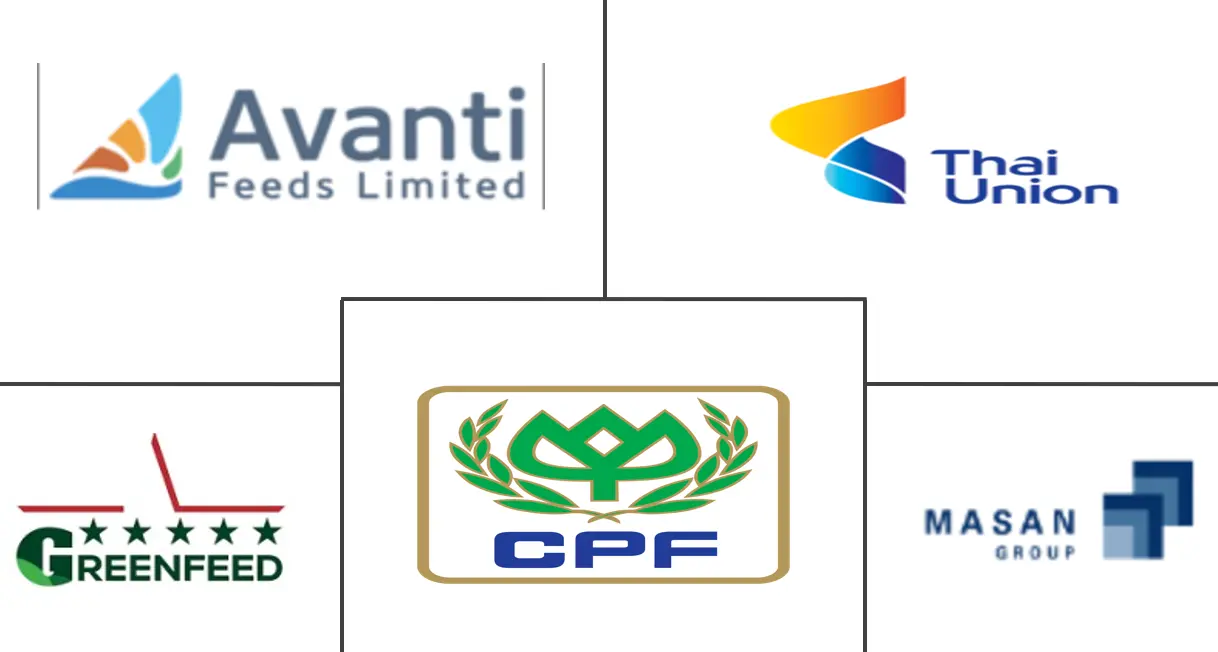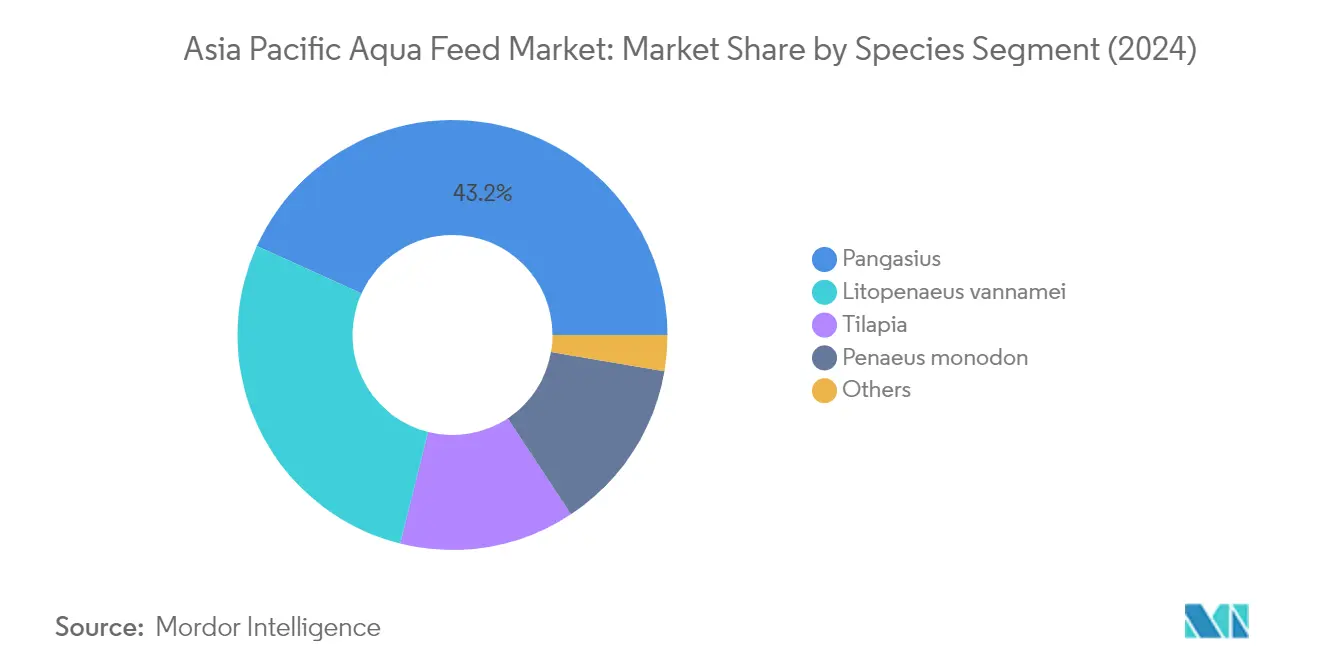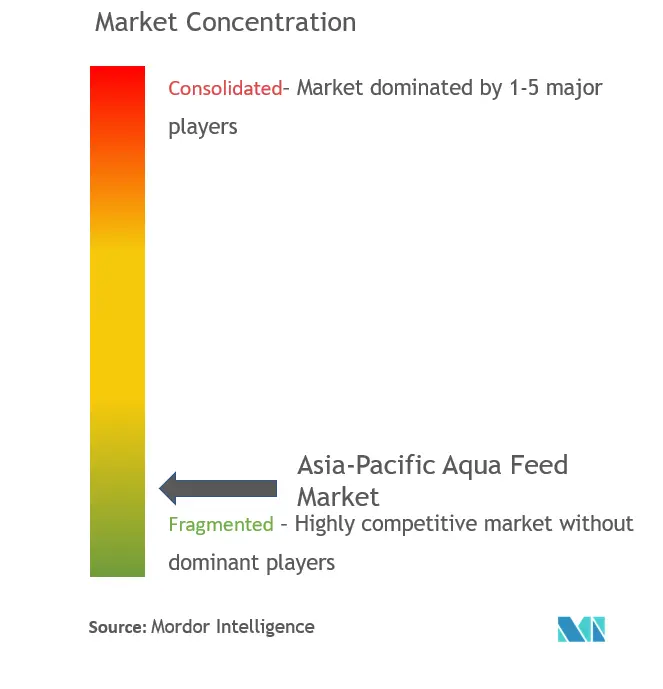
| Study Period | 2019 - 2030 |
| Base Year For Estimation | 2024 |
| Forecast Data Period | 2025 - 2030 |
| Market Size (2025) | USD 9.15 Billion |
| Market Size (2030) | USD 11.95 Billion |
| CAGR (2025 - 2030) | 5.50 % |
| Market Concentration | Medium |
Major Players
*Disclaimer: Major Players sorted in no particular order |
Asia Pacific Aqua Feed Market Analysis
The Asia Pacific Aqua Feed Market size is estimated at USD 9.15 billion in 2025, and is expected to reach USD 11.95 billion by 2030, at a CAGR of 5.5% during the forecast period (2025-2030).
The Asia Pacific aqua feed industry is experiencing a significant transformation driven by changing consumer preferences and dietary habits across the region. Traditional carbohydrate-heavy diets are gradually shifting towards protein-rich alternatives, with seafood emerging as a preferred protein source among health-conscious consumers. This dietary evolution has created a ripple effect throughout the aquaculture value chain, prompting aqua feed manufacturers to enhance their product formulations and nutritional profiles. The industry has also witnessed increased adoption of plant-based ingredients in feed formulations, including cereals, soybean meal, peanut meal, and cottonseed meal, particularly in rural regions.
The sector is witnessing substantial technological advancement and modernization of production facilities. Aqua feed manufacturers are increasingly investing in automated manufacturing processes and quality control systems, with many facilities now adhering to international standards and receiving third-party certifications. The integration of automation and advanced manufacturing technologies has not only improved production efficiency but also enabled better tracking of feed quality and consistency. This technological evolution has been particularly evident in the development of specialized aquaculture feed formulations for different aquaculture species and life stages.
A notable trend in the industry is the emergence of sustainable and environmentally conscious feed production practices. According to Vietnam's national plan, the country aims to achieve shrimp product export revenue of USD 10 billion by 2025, with a focus on sustainable production methods. This target is supported by plans to develop 750,000 hectares of brackish water shrimp farming area and achieve a total shrimp output exceeding 1.15 million metric tons. Aqua feed manufacturers are responding to these sustainability initiatives by developing eco-friendly feed formulations and implementing responsible sourcing practices for raw materials.
The aquaculture feed industry is experiencing a surge in innovation driven by the rise of aquaculture technology startups and increased private sector investment. These startups are introducing novel fish feed formulations, alternative protein sources, and digital solutions for feed management. The integration of technology in feed production and management has led to improved feed conversion ratios and reduced environmental impact. Companies are also focusing on developing specialized fish feed products that cater to specific growth stages and species requirements, incorporating advanced ingredients such as probiotics, essential nutrients, and immune-boosting compounds to enhance aquaculture nutrition and sustainability.
Asia Pacific Aqua Feed Market Trends
Increase in Fish Demand
The rising consumption of fish and fish products across the Asia-Pacific region is being driven by multiple socioeconomic factors, creating sustained demand growth for fish feed products. According to OECD data from 2021, fish consumption in Asia accounts for approximately 72% of the total food consumption in the region, with projections indicating aquaculture will provide 57% of fish for human consumption by 2030, compared to 53% in the current period. This substantial increase in consumption is attributed to growing urbanization, rising disposable incomes, and expanding middle-class populations across Asian countries who are increasingly seeking protein-rich dietary options.
The nutritional benefits of fish consumption have become a significant driver for increased demand, particularly due to their omega-3 fatty acid content, specifically eicosapentaenoic acid (EPA) and docosahexaenoic acid (DHA). Compared to traditional protein sources like beef, mutton, pork, and chicken, fish offers a healthier alternative with lower fat content while maintaining high protein values. This health-conscious trend among consumers, coupled with the growing awareness of fish nutrition and seafood's nutritional benefits, has created a strong foundation for sustained growth in fish demand, consequently driving the need for quality aqua feed products to support increased production.
Increased Adoption of Scientific Aquaculture Management Practices
The aquaculture industry across Asia-Pacific is witnessing a significant transformation through the implementation of Scientific Aquaculture Management Practices (SAMP), which is driving innovation in feed formulation and application. Over the years, the industry has evolved from traditional approaches to more sophisticated, technically advanced production methods. This shift is particularly evident in the development of species-specific feed formulations and the integration of modern farming technologies that focus on resource efficiency and environmental sustainability. The trend toward improved and integrated farming technology has been widely adopted across Asia, resulting in increased production, greater resource efficiency, and reduced environmental impact.
The adoption of scientific management practices has been further accelerated by government initiatives and private sector investments in research and development. For instance, in India, the presence of 71 aquaculture tech startups in 2021 demonstrates the growing emphasis on technological innovation in the sector. These startups are focusing on various aspects of aquaculture nutrition, including frequency of sediment removal, feed tray monitoring, fingerling density optimization, and water exchange frequency. This scientific approach to aquaculture management is creating new opportunities for feed manufacturers to develop specialized products that align with modern farming practices and optimize feed conversion ratios.
Increase in Export-Oriented Aquaculture
The Asia-Pacific region has emerged as a global powerhouse in aquaculture exports, with several countries developing robust export-oriented production systems that demand high-quality feed inputs. According to the Food and Agriculture Organization (FAO), Asian countries are the main producers, accounting for 70% of the total fisheries and production of aquatic animals, with significant portions being produced specifically for export markets. This export-oriented approach has led to increased adoption of international quality standards and certification requirements, driving demand for premium quality shrimp feed that meets global production standards.
The export potential has prompted governments across the region to implement strategic initiatives supporting commercial aquaculture development. For instance, Vietnam's fisheries development strategy plan aims to transform the country into a leading global seafood exporter, with the seafood industry expected to contribute 30-35% to the country's agro-forestry and fisheries GDP. Similarly, India's Marine Products Export Development Authority (MPEDA) has focused on expanding brackish water aquaculture across ten states and union territories, specifically targeting export-oriented species like white leg shrimp. These strategic initiatives are driving the demand for high-quality shrimp feed that can support the production of export-grade aquaculture products.
Segment Analysis: Species
Pangasius Segment in Asia Pacific Aqua Feed Market
The Pangasius segment dominates the Asia Pacific aqua feed market, holding approximately 43% market share in 2024. This significant market position is primarily driven by Vietnam's extensive pangasius farming operations, where the species is highly vertically integrated with 70% of fish volume farmed by processors using modern farming and processing technology. The segment's dominance is further strengthened by broad-based demand and high price levels in international markets, particularly in the Mekong Delta region. The expansion of pangasius farming areas, especially in regions like Long An Province, coupled with government initiatives such as the Sustainable Pangasius Supply Chain Project, has contributed to maintaining the segment's leading position in the market.

Litopenaeus Vannamei Segment in Asia Pacific Aqua Feed Market
The Litopenaeus vannamei (white leg shrimp) segment is projected to grow at approximately 6% CAGR during 2024-2029, emerging as the fastest-growing segment in the Asia Pacific aqua feed market. This robust growth is attributed to the increasing preference for white leg shrimp among farmers due to its faster growth rate, uniform harvest volume, and ability to be stocked at high density. The segment's growth is further supported by the rising adoption of scientific aquaculture management practices and the implementation of biofloc technology, which enhances shrimp nutrition and improves feed conversion ratios. Additionally, the expanding export market and growing domestic consumption across major producing countries are driving the demand for high-quality shrimp feed products.
Remaining Segments in Species Segmentation
The other significant segments in the Asia Pacific aquaculture feed market include Tilapia, Penaeus monodon (black tiger shrimp), Carp, Catfish, and various other species. The Tilapia segment maintains a strong presence due to its popularity in domestic markets and increasing adoption of commercial farming practices. Penaeus monodon remains important in traditional farming regions, particularly benefiting from premium pricing and established export markets. The Carp segment continues to be significant in traditional aquaculture regions, while Catfish feed demand is driven by increasing domestic consumption and export opportunities. These segments collectively contribute to the market's diversity and stability, each serving specific regional preferences and farming practices across the Asia Pacific region. The focus on fish nutrition and the development of specialized fish feed products are key to supporting these diverse segments.
Asia Pacific Aqua Feed Market Geography Segment Analysis
Asia Pacific Aqua Feed Market in Vietnam
Vietnam dominates the Asia Pacific aqua feed market, commanding approximately 41% of the total market share in 2024. The country's aquaculture sector has witnessed remarkable development, particularly in the Mekong Delta region, which serves as the primary hub for aquaculture production. Vietnam's success in the aqua feed market can be attributed to its well-established infrastructure, including modern feed mills and processing facilities. The country has also made significant strides in sustainable aquaculture practices, with many farmers adopting scientific aquaculture management techniques. Vietnamese aqua feed manufacturers have been focusing on developing specialized fish feed formulations for different species, particularly for pangasius and white leg shrimp, which are the country's major aquaculture exports. The government's supportive policies and initiatives, including the development of aquaculture zones and the promotion of sustainable farming practices, have further strengthened Vietnam's position in the market.
Asia Pacific Aqua Feed Market in Indonesia
Indonesia stands out as the most dynamic market in the Asia Pacific aqua feed sector, with a projected growth rate of approximately 6% during 2024-2029. The country's rapid expansion in the aquaculture feed market is driven by its ambitious aquaculture development programs and increasing adoption of intensive farming practices. Indonesia's vast coastline and abundant water resources provide ideal conditions for aquaculture development. The government's focus on promoting sustainable aquaculture practices and improving feed quality standards has attracted significant investments in the sector. Local feed manufacturers have been investing in research and development to create innovative shrimp feed formulations that cater to various species, particularly tilapia and shrimp. The country's strategic location and improving infrastructure have also facilitated better distribution networks for aqua feed products. Additionally, the growing awareness among farmers about the benefits of quality fish feed in improving yield and reducing disease outbreaks has contributed to market growth.
Asia Pacific Aqua Feed Market in India
India has emerged as a significant player in the Asia Pacific aqua feed market, driven by its expanding aquaculture sector and increasing export-oriented production. The country's aquaculture feed industry has witnessed substantial technological advancement, with manufacturers adopting modern production techniques and quality control measures. India's diverse aquaculture landscape, ranging from freshwater to brackish water farming, has created a varied demand for specialized fish farming feed products. The country has developed a robust distribution network, ensuring feed availability across major aquaculture regions. Local manufacturers have been focusing on developing cost-effective yet nutritious fish feed formulations, particularly for species like shrimp and carp. The implementation of scientific farming practices and increasing awareness about feed quality among farmers have further strengthened the market. Additionally, the government's initiatives to promote aquaculture through various schemes and support programs have created a favorable environment for market growth.
Asia Pacific Aqua Feed Market in Thailand
Thailand has established itself as a key player in the Asia Pacific aqua feed market, leveraging its strong aquaculture heritage and advanced technological capabilities. The country's aqua feed industry is characterized by its focus on quality and innovation, with manufacturers investing in state-of-the-art production facilities. Thailand's aqua feed sector benefits from its well-developed research and development infrastructure, enabling the creation of specialized feed formulations for various aquatic species. The country has also made significant progress in sustainable feed production practices, incorporating alternative protein sources and environmentally friendly ingredients. Thai manufacturers have been particularly successful in developing high-performance shrimp feed for shrimp and tilapia, which are major export commodities. The presence of several multinational feed companies has fostered healthy competition and innovation in the market. Furthermore, Thailand's strong focus on quality control and food safety standards has enhanced its reputation in the international market.
Asia Pacific Aqua Feed Market in Other Countries
The aqua feed market in other Asia Pacific countries, particularly the Philippines, demonstrates unique characteristics and growth patterns shaped by local aquaculture practices and market demands. These markets are characterized by increasing modernization of aquaculture practices and growing awareness about the importance of quality marine feed in aquaculture production. Local manufacturers in these countries are focusing on developing region-specific feed formulations that cater to indigenous species and local farming conditions. The markets are witnessing a gradual shift from traditional feeding methods to commercial feeds, driven by the need for better productivity and disease resistance. Government support through various aquaculture development programs and increasing private sector investments are helping these markets evolve. The growing emphasis on sustainable aquaculture practices and the adoption of new technologies in feed production are expected to drive future market development in these regions.
Asia Pacific Aqua Feed Industry Overview
Top Companies in Asia Pacific Aqua Feed Market
The Asia Pacific aqua feed market is characterized by intense competition and continuous innovation among key players. Companies are focusing on developing specialized feed formulations with enhanced nutritional profiles and sustainable ingredients to meet evolving aquaculture needs. Operational agility has become paramount, with manufacturers investing in automated production facilities and advanced quality control systems to ensure consistent product quality. Strategic partnerships with research institutions and local farming communities have emerged as a crucial trend, enabling companies to develop region-specific solutions. Market leaders are expanding their geographical presence through new manufacturing facilities and distribution networks, particularly in emerging aquaculture hubs. The industry has witnessed significant investment in research and development, focusing on alternative protein sources and environmentally sustainable feed solutions to address growing environmental concerns.
Fragmented Market with Strong Regional Players
The aquaculture feed market in Asia Pacific exhibits a unique blend of global conglomerates and specialized regional players, each leveraging their distinct advantages. Global players bring advanced technology and research capabilities, while local manufacturers excel in understanding regional farming practices and maintaining strong distributor relationships. The market remains relatively fragmented, with numerous small and medium-sized enterprises serving specific geographical regions or species segments. This fragmentation has created opportunities for strategic consolidation, particularly in high-growth markets like Vietnam, Indonesia, and India.
The industry has witnessed selective merger and acquisition activities, primarily driven by global players seeking to strengthen their regional presence and local players aiming to expand their technological capabilities. Vertical integration has emerged as a prominent strategy, with feed manufacturers acquiring or partnering with farming operations and processing facilities. Companies are increasingly focusing on building integrated supply chains to ensure raw material security and maintain quality control throughout the production process. The market structure continues to evolve with new entrants bringing innovative solutions and established players expanding their product portfolios through strategic acquisitions.
Innovation and Sustainability Drive Future Growth
Success in the Asia Pacific aqua feed market increasingly depends on companies' ability to innovate while maintaining cost competitiveness. Market leaders are investing in research and development to create specialized feed formulations for different species and growth stages, while also focusing on improving feed conversion ratios. The adoption of sustainable practices, including the use of alternative protein sources and environmentally friendly production processes, has become crucial for maintaining market position. Companies are also strengthening their distribution networks and technical support services to build stronger relationships with end-users.
For new entrants and smaller players, success lies in identifying and serving niche segments while building strong local partnerships. The market presents opportunities for companies that can offer specialized solutions for specific species or regional requirements. Regulatory compliance, particularly regarding environmental standards and feed quality, continues to shape market dynamics. The concentration of end-users varies by region, with some markets dominated by large commercial farms while others feature numerous small-scale operators. Companies must adapt their strategies accordingly, considering factors such as local farming practices, environmental regulations, and economic conditions in each target market. The focus on fish nutrition and aquaculture nutrition is becoming increasingly important as companies aim to enhance marine nutrition and overall feed quality.
Asia Pacific Aqua Feed Market Leaders
-
Charoen Popkhand Group
-
Avanti Feeds Ltd
-
Masan Group
-
Thai Union Group
-
Greenfeed Vietnam
- *Disclaimer: Major Players sorted in no particular order

Asia Pacific Aqua Feed Market News
November 2021: Avanti Feeds expanded its feed manufacturing capacity at Unit-IV Bandapuram, Andhra Pradesh, to a capacity of 175,000 metric ton by setting up a new plant for the manufacture of shrimp feed.
October 2021: Charoen Pokphand Foods (CP Foods) announced its plan to raise its ownership in CP Pokphand (CPP), its Hong Kong-listed arm, which has aqua feed and livestock operations in Vietnam and China.
April 2021: Thai Union Feedmill Public Company Limited established a new livestock and aqua feed manufacturing and distribution joint venture in Pakistan, called AMG-Thaiunion Feedmill (Private) Limited. Thai Union Feedmill is expected to own a 51% stake in the new joint venture.
Asia Pacific Aqua Feed Market Report - Table of Contents
1. INTRODUCTION
- 1.1 Study Assumptions and Market Definition
- 1.2 Scope of the Study
2. RESEARCH METHODOLOGY
3. EXECUTIVE SUMMARY
4. MARKET DYNAMICS
- 4.1 Market Overview
- 4.2 Market Drivers
- 4.3 Market Restraints
-
4.4 Porter's Five Forces Analysis
- 4.4.1 Bargaining Power of Suppliers
- 4.4.2 Bargaining Power of Buyers/Consumers
- 4.4.3 Threat of New Entrants
- 4.4.4 Threat of Substitute Products
- 4.4.5 Intensity of Competitive Rivalry
5. MARKET SEGMENTATION
-
5.1 India Aqua Feed Market
- 5.1.1 Species
- 5.1.1.1 Litopenaeus vannamei
- 5.1.1.2 Penaeus monodon
- 5.1.1.3 Pangasius
- 5.1.1.4 Carp
- 5.1.1.5 Catfish
- 5.1.1.6 Tilapia
- 5.1.1.7 Other Species
-
5.2 Vietnam Aqua Feed Market
- 5.2.1 Species
- 5.2.1.1 Litopenaeus vannamei
- 5.2.1.2 Penaeus monodon
- 5.2.1.3 Pangasius
- 5.2.1.4 Carp
- 5.2.1.5 Catfish
- 5.2.1.6 Tilapia
- 5.2.1.7 Other Species
-
5.3 Thailand Aqua Feed Market
- 5.3.1 Species
- 5.3.1.1 Litopenaeus vannamei
- 5.3.1.2 Penaeus monodon
- 5.3.1.3 Pangasius
- 5.3.1.4 Carp
- 5.3.1.5 Catfish
- 5.3.1.6 Tilapia
- 5.3.1.7 Other Species
-
5.4 Indonesia Aqua Feed Market
- 5.4.1 Species
- 5.4.1.1 Litopenaeus vannamei
- 5.4.1.2 Penaeus monodon
- 5.4.1.3 Pangasius
- 5.4.1.4 Carp
- 5.4.1.5 Catfish
- 5.4.1.6 Tilapia
- 5.4.1.7 Other Species
-
5.5 Philippines Aqua Feed Market
- 5.5.1 Species
- 5.5.1.1 Litopenaeus vannamei
- 5.5.1.2 Penaeus monodon
- 5.5.1.3 Pangasius
- 5.5.1.4 Carp
- 5.5.1.5 Catfish
- 5.5.1.6 Tilapia
- 5.5.1.7 Other Species
6. COMPETITIVE LANDSCAPE
- 6.1 Most Adopted Strategies
- 6.2 Market Share Analysis
-
6.3 Company Profiles
- 6.3.1 Avanti Feeds Ltd
- 6.3.2 Godrej Agrovet Ltd
- 6.3.3 Growel Feeds Pvt. Ltd
- 6.3.4 The Waterbase Ltd
- 6.3.5 Grobest International
- 6.3.6 Thai Union Group
- 6.3.7 Inve Aquaculture Inc.
- 6.3.8 Charoen Popkhand Group
- 6.3.9 PT Japfa Comfeed Indonesia Tbk
- 6.3.10 Pilmico Animal Nutrition Joint Stock Company
- 6.3.11 Greenfeed Vietnam
- 6.3.12 Masan Group
- 6.3.13 Vitarich Corporation
- 6.3.14 Santeh Feeds Corporation
- *List Not Exhaustive
7. MARKET OPPORTUNITIES AND FUTURE TRENDS
Asia Pacific Aqua Feed Industry Segmentation
Aqua feed forms an integral part of commercial and personal aquaculture and provides a wholesome and balanced diet for farmed fish. Aqua feed is primarily sourced from vegetables, grains, oilseeds, and other significant components. The Asia-Pacific aqua feed market is segmented by species into Litopenaeus vannamei, Penaeus monodon, Pangasius, Carp, Catfish, Tilapia, and Other Species and by Geography into India, Vietnam, Thailand, Indonesia, and the Philippines. A detailed country-wise analysis of every species type is provided in the report. The report offers an estimation and forecast of the market in value (USD million) for the abovementioned segments.
| India Aqua Feed Market | Species | Litopenaeus vannamei |
| Penaeus monodon | ||
| Pangasius | ||
| Carp | ||
| Catfish | ||
| Tilapia | ||
| Other Species | ||
| Vietnam Aqua Feed Market | Species | Litopenaeus vannamei |
| Penaeus monodon | ||
| Pangasius | ||
| Carp | ||
| Catfish | ||
| Tilapia | ||
| Other Species | ||
| Thailand Aqua Feed Market | Species | Litopenaeus vannamei |
| Penaeus monodon | ||
| Pangasius | ||
| Carp | ||
| Catfish | ||
| Tilapia | ||
| Other Species | ||
| Indonesia Aqua Feed Market | Species | Litopenaeus vannamei |
| Penaeus monodon | ||
| Pangasius | ||
| Carp | ||
| Catfish | ||
| Tilapia | ||
| Other Species | ||
| Philippines Aqua Feed Market | Species | Litopenaeus vannamei |
| Penaeus monodon | ||
| Pangasius | ||
| Carp | ||
| Catfish | ||
| Tilapia | ||
| Other Species |
Asia Pacific Aqua Feed Market Research FAQs
How big is the Asia Pacific Aqua Feed Market?
The Asia Pacific Aqua Feed Market size is expected to reach USD 9.15 billion in 2025 and grow at a CAGR of 5.5% to reach USD 11.95 billion by 2030.
What is the current Asia Pacific Aqua Feed Market size?
In 2025, the Asia Pacific Aqua Feed Market size is expected to reach USD 9.15 billion.
Who are the key players in Asia Pacific Aqua Feed Market?
Charoen Popkhand Group, Avanti Feeds Ltd, Masan Group, Thai Union Group and Greenfeed Vietnam are the major companies operating in the Asia Pacific Aqua Feed Market.
What years does this Asia Pacific Aqua Feed Market cover, and what was the market size in 2024?
In 2024, the Asia Pacific Aqua Feed Market size was estimated at USD 8.65 billion. The report covers the Asia Pacific Aqua Feed Market historical market size for years: 2019, 2020, 2021, 2022, 2023 and 2024. The report also forecasts the Asia Pacific Aqua Feed Market size for years: 2025, 2026, 2027, 2028, 2029 and 2030.
Our Best Selling Reports
Asia Pacific Aqua Feed Market Research
Mordor Intelligence provides comprehensive insights into the aqua feed industry. Our detailed analysis covers fish nutrition trends and aquaculture feed developments. We explore various segments, including shrimp feed, marine feed, and fish meal feed products. This research offers stakeholders crucial data on fish feed manufacturing and distribution across the Asia Pacific region. The report, available as an easy-to-download PDF, examines essential aspects of marine nutrition and aquaculture nutrition that influence industry dynamics.
Our in-depth analysis benefits industry participants by offering actionable insights into fish farming feed operations and evolving aquaculture diet requirements. The research methodology includes a detailed examination of feed formulation technologies, nutrition optimization strategies, and emerging trends in the fish food sector. Stakeholders gain valuable understanding of regional market dynamics, technological innovations, and strategic opportunities through this comprehensive report. It delivers essential data for informed decision-making in the rapidly evolving Asia Pacific aquaculture sector.




